Design of a Waterborne Polyurethane–Urea Ink for Direct Ink Writing 3D Printing
Abstract
1. Introduction
2. Experimental Part
2.1. Materials
2.2. Synthesis of the WBPUU Inks
2.3. DIW 3D Printing of Prepared Inks
2.4. Characterization
3. Results and Discussion
4. Conclusions
Supplementary Materials
Author Contributions
Funding
Institutional Review Board Statement
Informed Consent Statement
Data Availability Statement
Acknowledgments
Conflicts of Interest
References
- Murphy, S.V.; Atala, A. Review 3D bioprinting of tissues and organs. Nat. Publ. Group 2014, 32, 773–785. [Google Scholar] [CrossRef]
- Kang, H.; Lee, S.J.; Ko, I.K.; Kengla, C.; Yoo, J.J.; Atala, A. A 3D bioprinting system to produce human-scale tissue constructs with structural integrity. Nat. Biotechnol. 2016, 34, 312–319. [Google Scholar] [CrossRef] [PubMed]
- Visser, J.; Peters, B.; Burger, T.J.; Boomstra, J.; Dhert, W.J.A.; Melchels, F.P.W.; Malda, J. Biofabrication of multi-material anatomically shaped tissue constructs. Biofabrication 2013, 5, 1–9. [Google Scholar] [CrossRef]
- Chang, R.; Nam, J.A.E.; Sun, W.E.I. Effects of Dispensing Pressure and Nozzle Diameter Direct Cell Writing. Tissue Eng. Part A 2008, 14. [Google Scholar] [CrossRef]
- Lille, M.; Nurmela, A.; Nordlund, E.; Metsa-Kortelainen, S.; Sozer, N. Applicability of protein and fiber-rich food materials in extrusion-based 3D printing. J. Food Eng. 2018, 220, 20–27. [Google Scholar] [CrossRef]
- Hiller, A.; Borchers, K.; Tovar, G.E.M.; Southan, A. Impact of intermediate UV curing and yield stress of 3D printed poly ( ethylene glycol ) diacrylate hydrogels on interlayer connectivity and maximum build height. Addit. Manuf. 2017, 18, 136–144. [Google Scholar] [CrossRef]
- Chen, R.; Huang, C.; Hsu, S. Composites of waterborne polyurethane and cellulose nanofibers for 3D printing and bioapplications. Carbohydr. Polym. 2019, 212, 75–88. [Google Scholar] [CrossRef] [PubMed]
- Hung, K.C.; Tseng, C.S.; Hsu, S.H. 3D Printing of Polyurethane Biomaterials. Advances in Polyurethane Biomaterials; Elsevier Ltd.: Amsterdam, The Netherlands, 2016. [Google Scholar] [CrossRef]
- Hung, K.; Tseng, C.; Hsu, S. Synthesis and 3D Printing of Biodegradable Polyurethane Elastomer by a Water-Based Process for Cartilage Tissue Engineering Applications. Adv. Healthc. Mater. 2014, 3, 1578–1587. [Google Scholar] [CrossRef]
- Siqueira, G.; Kokkinis, D.; Libanori, R.; Hausmann, M.K.; Gladman, A.S.; Neels, A.; Tingaut, P.; Zimmermann, T.; Lewis, J.A.; Studart, A.R. Cellulose Nanocrystal Inks for 3D Printing of Textured Cellular Architectures. Adv. Funct. Mater. 2017, 27, 1604619. [Google Scholar] [CrossRef]
- Hung, K.; Tseng, C.; Dai, L.; Hsu, S. Water-based polyurethane 3D printed scaffolds with controlled release function for customized cartilage tissue engineering. Biomaterials 2016, 83, 156–168. [Google Scholar] [CrossRef]
- Feng, Z.; Wang, D.; Zheng, Y.; Zhao, L.; Xu, T.; Guo, Z.; Hussain, M.I.; Zeng, J.; Lou, L.; Sun, Y.; et al. A novel waterborne polyurethane with biodegradability and high flexibility for 3D printing. Biofabrication 2020, 12. [Google Scholar] [CrossRef] [PubMed]
- Hsieh, F.Y.; Lin, H.H.; Hsu, S.-h. 3D bioprinting of neural stem cell-laden thermoresponsive biodegradable polyurethane hydrogel and potential in central nervous system repair. Biomaterials 2015, 71, 48–57. [Google Scholar] [CrossRef]
- Vadillo, J.; Larraza, I.; Calvo-Correas, T.; Gabilondo, N.; Derail, C.; Eceiza, A. Role of in situ added cellulose nanocrystals as rheological modulator of novel waterborne polyurethane urea for 3D-printing technology. Cellulose 2021, 6. [Google Scholar] [CrossRef]
- Serra, T.; Ortiz-Hernandez, M.; Engel, E.; Planell, J.A.; Navarro, M. Relevance of PEG in PLA-based blends for tissue engineering 3D-printed scaffolds. Mater. Sci. Eng. C 2014, 38, 55–62. [Google Scholar] [CrossRef]
- Ilhan, E.; Cesur, S.; Guler, E.; Topal, F.; Albayrak, D.; Guncu, M.M.; Cam, M.E.; Taskin, T.; Sasmazel, H.T.; Aksu, B.; et al. Development of Satureja cuneifolia-loaded sodium alginate/polyethylene glycol scaffolds produced by 3D-printing technology as a diabetic wound dressing material. Int. J. Biol. Macromol. 2020, 161, 1040–1054. [Google Scholar] [CrossRef]
- Santamaria-Echart, A.; Fernandes, I.; Barreiro, F.; Corcuera, M.A.; Eceiza, A. Advances in waterborne polyurethane and polyurethane-urea dispersions and their eco-friendly derivatives: A review. Polymers 2021, 13, 409. [Google Scholar] [CrossRef]
- Santamaria-echart, A.; Fernandes, I.; Barreiro, F.; Retegi, A.; Arbelaiz, A.; Corcuera, M.A.; Eceiza, A. Development of waterborne polyurethane-ureas added with plant extracts: Study of different incorporation routes and their influence o particle size, thermal, mechanical and antibacterial properties. Prog. Org. Coat. 2018, 117, 76–90. [Google Scholar] [CrossRef]
- Santamaria-Echart, A.; Fernandes, I.; Ugarte, L.; Barreiro, F.; Corcuera, M.A.; Eceiza, A. Green nanocomposites from Salvia-based waterborne polyurethane-urea dispersions reinforced with nanocellulose. Prog. Org. Coat. 2021, 150, 105989. [Google Scholar] [CrossRef]
- Larraza, I.; Vadillo, J.; Calvo-correas, T.; Tejado, A.; Olza, S.; Peña-Rodríguez, C.; Arbelaiz, A.; Eceiza, A. Cellulose and Graphene Based Polyurethane Nanocomposites for FDM 3D Printing: Filament Properties and Printability. Polymers 2021, 13, 839. [Google Scholar] [CrossRef]
- Vadillo, J.; Larraza, I.; Arbelaiz, A.; Corcuera, M.A.; Save, M.; Derail, C.; Eceiza, A. Influence of the addition of PEG into PCL-based waterborne polyurethane-urea dispersions and films properties. J. Appl. Polym. Sci. 2020, 137, 48847. [Google Scholar] [CrossRef]
- Janna, W.S. Introduction to Fluid Mechanics, 4th ed.; CRC Press: Boston, MA, USA, 2010. [Google Scholar]
- Han, C.D. Rheology in Polymer Proccessing; Academic Press: New York, NY, USA, 1976. [Google Scholar]
- Calafel, I.; Aguirresarobe, R.H.; Peñas, M.I.; Santamaria, A.; Tierno, M.; Conde, J.I.; Pascual, B. Searching for Rheological Conditions for FFF 3D Printing with PVC Based Flexible Compounds. Materials 2020, 13, 178. [Google Scholar] [CrossRef]
- Fourmann, O.; Hausmann, M.K.; Neels, A.; Schubert, M.; Nyström, G.; Zimmermann, T.; Siqueira, G. 3D printing of shape-morphing and antibacterial anisotropic nanocellulose hydrogels. Carbohydr. Polym. 2021, 259, 117716. [Google Scholar] [CrossRef]
- ISO 527-1. Determination of tensile properties — Part 1: General principles; ISO: Geneva, Switzerland, 2019. [Google Scholar]
- Soltan, N.; Ning, L.; Mohabatpour, F.; Papagerakis, P.; Chen, X. Printability and Cell Viability in Bioprinting Alginate Dialdehyde-Gelatin Scaffolds. ACS Biomater. Sci. Eng. 2019, 5, 2976–2987. [Google Scholar] [CrossRef] [PubMed]
- Naghieh, S.; Chen, D. Printability–A Key Issue in Extrusion-based Bioprinting. J. Pharm. Anal. 2021, in press. [Google Scholar] [CrossRef]
- Dutta, S.D.; Hexiu, J.; Patel, D.K.; Ganguly, K.; Lim, K.T. 3D-printed bioactive and biodegradable hydrogel scaffolds of alginate/gelatin/cellulose nanocrystals for tissue engineering. Int. J. Biol. Macromol. 2021, 167, 644–658. [Google Scholar] [CrossRef]
- Markstedt, K.; Mantas, A.; Tournier, I.; Ha, D.; Gatenholm, P. 3D Bioprinting Human Chondrocytes with Nanocellulose−Alginate Bioink for Cartilage Tissue Engineering Applications. Biomacromolecules 2015, 16, 1489–1496. [Google Scholar] [CrossRef]
- Guvendiren, M.; Lu, H.D.; Burdick, J.A. Shear-thinning hydrogels for biomedical applications. Soft Matter 2012, 8, 260–272. [Google Scholar] [CrossRef]
- Gupta, R.K.; Pasanovic-Zujo, V.; Bhattacharya, S.N. Shear and extensional rheology of EVA/layered silicate-nanocomposites. J. Non-Newton. Fluid Mech. 2005, 128, 116–125. [Google Scholar] [CrossRef]
- Cyriac, F.; Lugt, P.M.; Bosman, R. On a New Method to Determine the Yield Stress in Lubricating Grease On a New Method to Determine the Yield Stress in Lubricating Grease. Tribol. Trans. 2015, 58, 1021–1030. [Google Scholar] [CrossRef]
- Corker, A.; Ng, H.C.; Garcı, E.; Poole, R.J. 3D printing with 2D colloids: Designing rheology protocols to predict printability of sof-materials. Soft Matter 2019, 15, 1444–1456. [Google Scholar] [CrossRef]
- Ketel, S.; Falzone, G.; Wang, B.; Washburn, N.; Sant, G. A printability index for linking slurry rheology to the geometrical attributes of 3D-printed components. Cem. Concr. Compos. 2018, 101, 32–43. [Google Scholar] [CrossRef]
- Wiesner, V.L.; Rueschhoff, L.M.; Diaz-cano, A.I.; Trice, R.W.; Youngblood, J.P. Producing dense zirconium diboride components by room-temperature injection molding of aqueous ceramic suspensions. Ceram. Int. 2016, 42, 2750–2760. [Google Scholar] [CrossRef]
- Chan, S.S.L.; Pennings, R.M.; Edwards, L.; Franks, G.V. 3D printing of clay for decorative architectural applications: Effect of solids volume fraction on rheology and printability. Addit. Manuf. 2020, 35, 101335. [Google Scholar] [CrossRef]
- Franks, G.V.; Johnson, S.B.; Scales, P.J.; Boger, D.V.; Healy, T.W. Ion-specific strength of attractive particle networks. Langmuir 1999, 15, 4411–4420. [Google Scholar] [CrossRef]
- Mezger, T.G. The Rheology Handbook; Vincentz Network GmbH Co: Hannover, Germany, 2006. [Google Scholar]
- Truby, R.L.; Lewis, J.A. Printing soft matter in three dimensions. Nature 2016, 540, 371–378. [Google Scholar] [CrossRef] [PubMed]
- Liu, Z.; Zhang, M.; Bhandari, B.; Yang, C. Impact of rheological properties of mashed potatoes on 3D printing. J. Food Eng. 2017, 220, 76–82. [Google Scholar] [CrossRef]
- Costakis, W.J.; Rueschhoff, L.M.; Diaz-cano, A.I.; Youngblood, J.P.; Trice, R.W. Additive manufacturing of boron carbide via continuous filament direct ink writing of aqueous ceramic suspensions. J. Eur. Ceram. Soc. 2016, 36, 3249–3256. [Google Scholar] [CrossRef]
- Abouzeid, R.E.; Khiari, R.; Beneventi, D.; Dufresne, A. Biomimetic Mineralization of Three-Dimensional Printed Alginate/TEMPO-Oxidized Cellulose Nanofibril Scaffolds for Bone Tissue Engineering. Biomacromolecules 2018, 19, 4442–4452. [Google Scholar] [CrossRef] [PubMed]
- Jiang, J.; Oguzlu, H.; Jiang, F. 3D printing of lightweight, super-strong yet flexible all-cellulose structure. Chem. Eng. J. 2021, 405, 126668. [Google Scholar] [CrossRef]
- Li, L.; Lin, Q.; Tang, M.; Duncan, A.J.E.; Ke, C. Advanced Polymer Designs for Direct-Ink-Write 3D Printing. Chem. A Eur. J. 2019, 1–15. [Google Scholar] [CrossRef]
- Álvarez-Castillo, E.; Oliveira, S.; Bengoechea, C.; Sousa, I.; Raymundo, A.; Guerrero, A. A rheological approach to 3D printing of plasma protein based doughs. J. Food Eng. 2021, 288. [Google Scholar] [CrossRef]
- Peak, C.W.; Stein, J.; Gold, K.A.; Gaharwar, A.K. Nanoengineered Colloidal Inks for 3D Bioprinting. Langmuir 2017, 34, 917–925. [Google Scholar] [CrossRef] [PubMed]
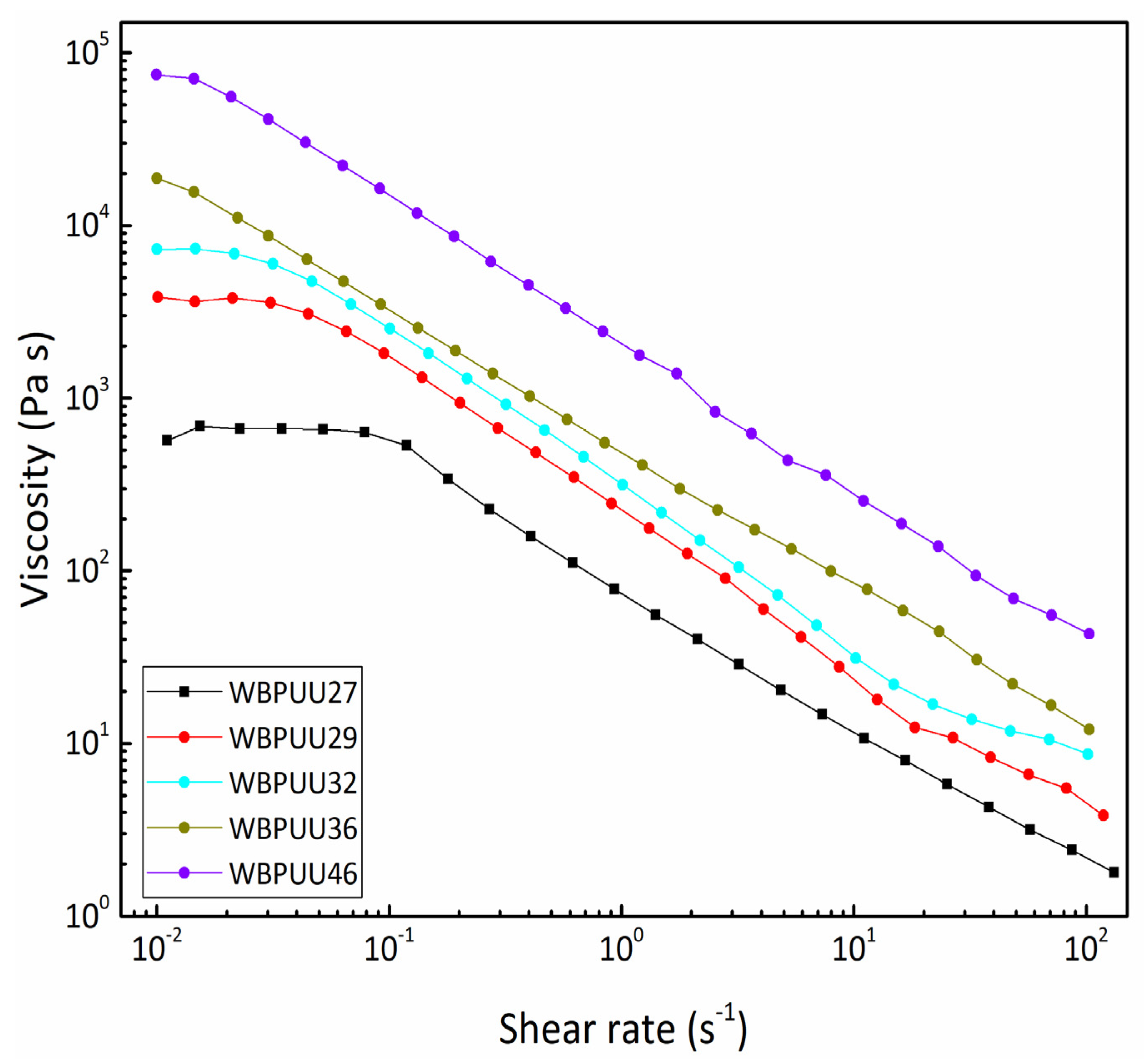
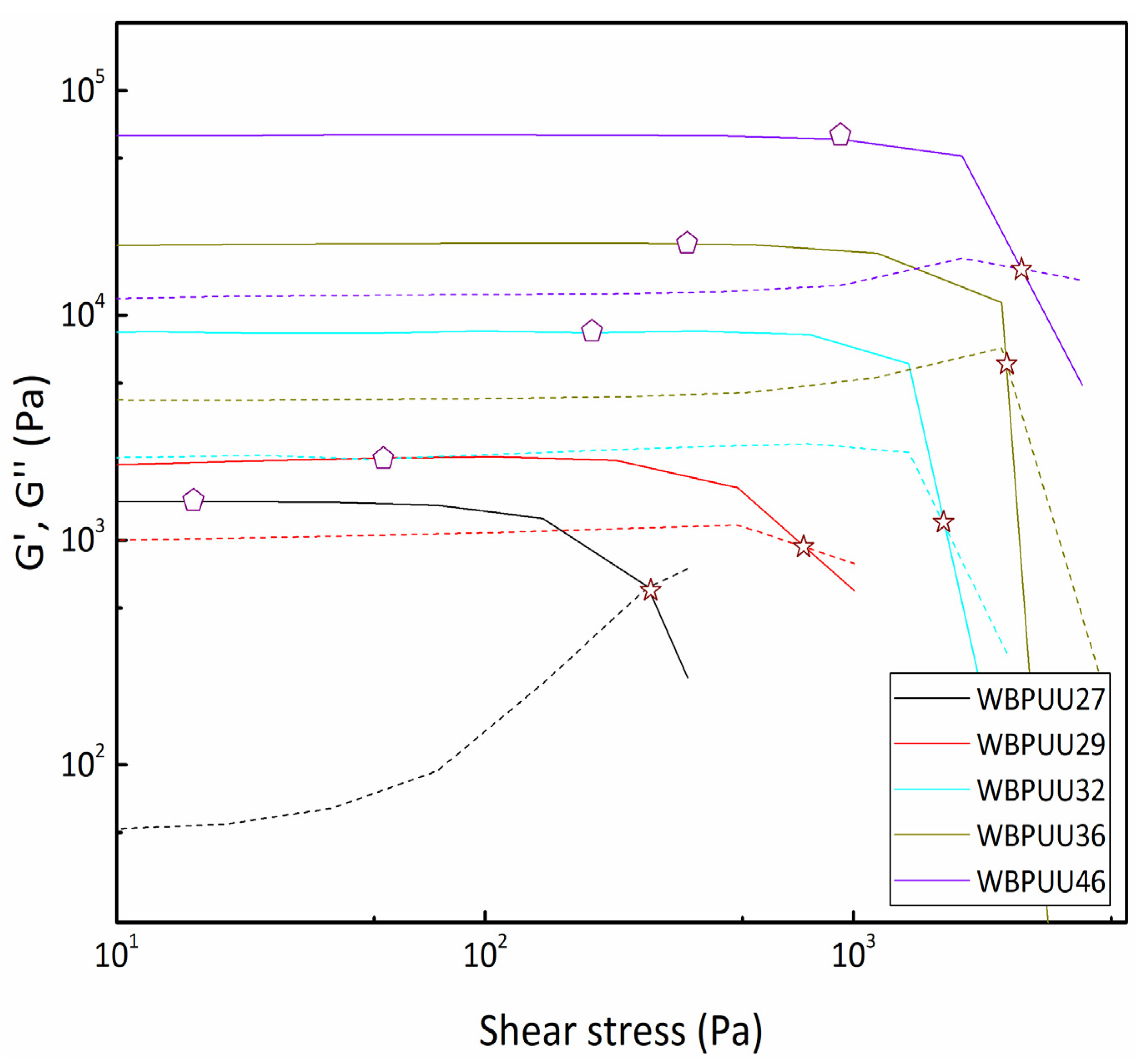
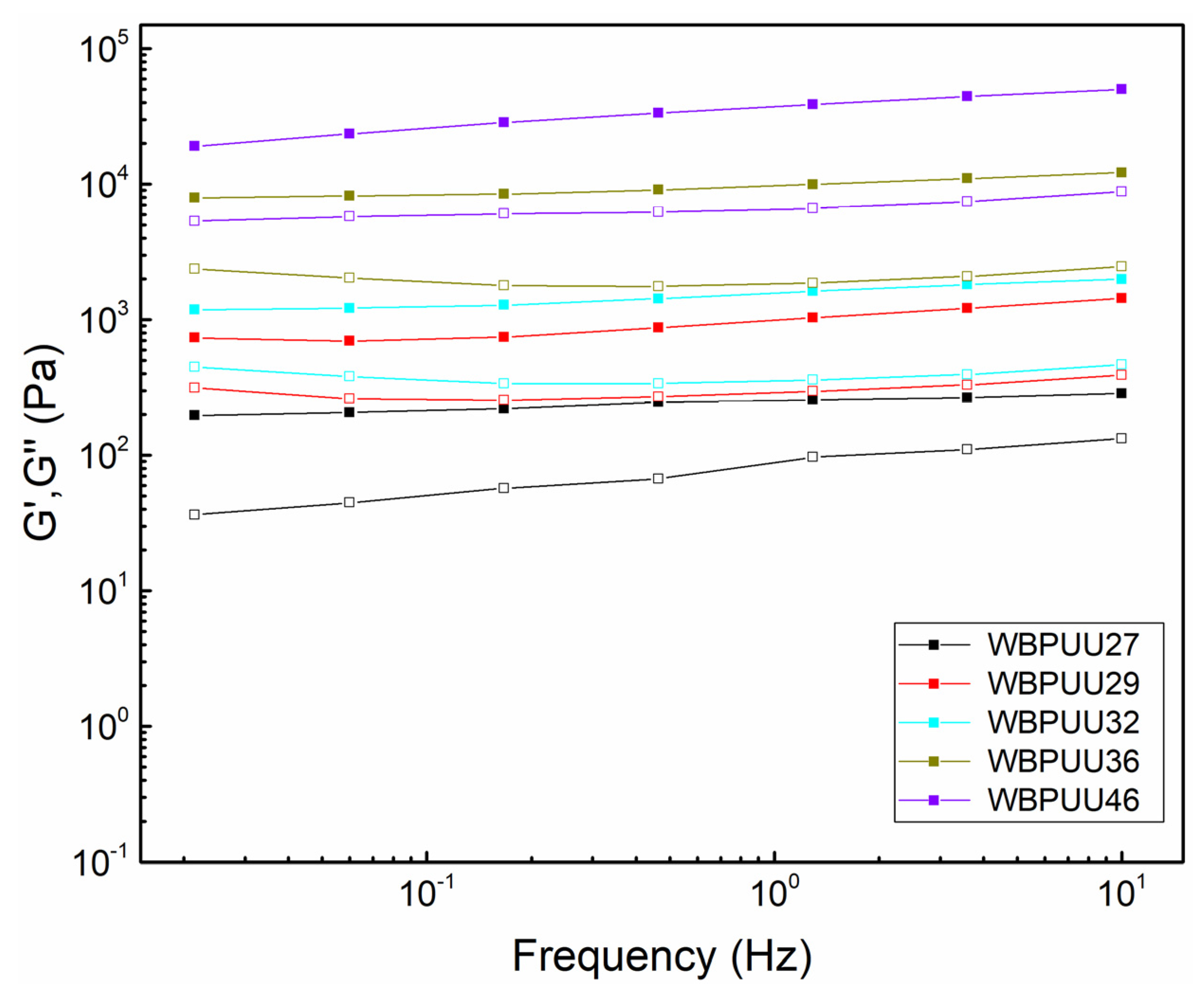
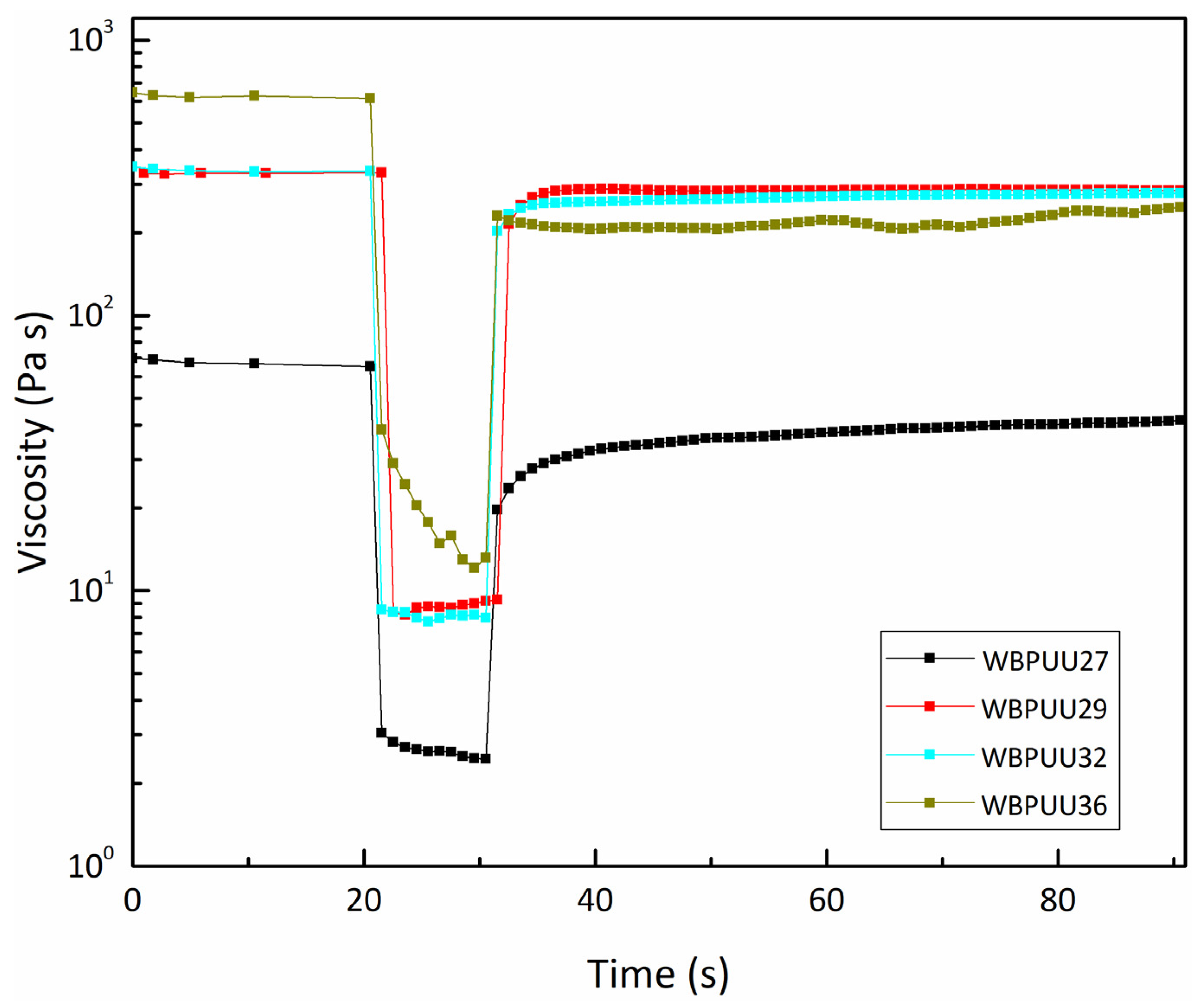
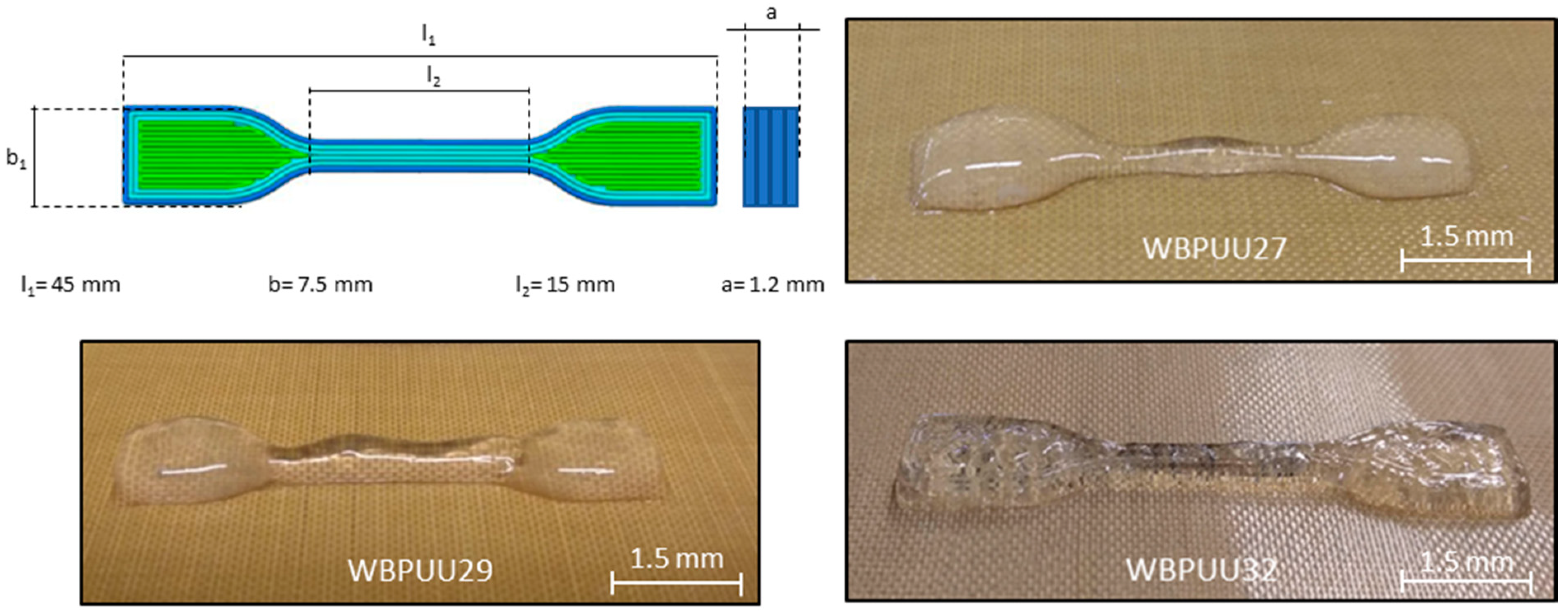

| Ink | Calculated Solid Content (wt%) |
|---|---|
| WBPUU27 | 27 |
| WBPUU29 | 29 |
| WBPUU32 | 32 |
| WBPUU36 | 36 |
| WBPUU46 | 46 |
| System | Yield Point (Pa) | Flow Point (Pa) | FTI | Herschel–Bulkley Model | ||
|---|---|---|---|---|---|---|
| K Index | N Index | R2 | ||||
| WBPUU27 | 17 | 282 | 16 | 72 | 0.24 | 0.97 |
| WBPUU29 | 44 | 562 | 13 | 177 | 0.15 | 0.92 |
| WBPUU32 | 195 | 1755 | 9 | 238 | 0.14 | 0.84 |
| WBPUU36 | 354 | 2608 | 7 | 303 | 0.37 | 0.98 |
| WBPUU46 | 921 | 2857 | 3 | 1032 | 0.20 | 0.94 |
| System | Storage Modulus (Pa) | Loss Modulus (Pa) | Complex Modulus (Pa) | Tan δ | Structure Recovery (%) |
|---|---|---|---|---|---|
| WBPUU27 | 206 | 106 | 231 | 0.52 | 63 |
| WBPUU29 | 1033 | 296 | 1075 | 0.29 | 84 |
| WBPUU32 | 1618 | 359 | 1657 | 0.22 | 83 |
| WBPUU36 | 9966 | 1865 | 10,139 | 0.19 | 40 |
| WBPUU46 | 38,738 | 6630 | 39,301 | 0.17 | - |
| System | Dimensions of Printed Pieces (mm) | Integrity Factor | |||
|---|---|---|---|---|---|
| l1 | l2 | b1 | a | ||
| CAD model | 45 | 15 | 7.50 | 1.2 | - |
| WBPUU27 | 45.10 ± 0.03 | 15.01 ± 0.01 | 7.55 ± 0.02 | 0.93 ± 0.02 | 0.78 ± 0.05 |
| WBPUU29 | 45.03 ± 0.01 | 15.01 ± 0.01 | 7.53 ± 0.01 | 1.02 ± 0.03 | 0.85 ± 0.02 |
| WBPUU32 | 44.99 ± 0.01 | 15.00 ± 0.00 | 7.50 ± 0.01 | 1.19 ± 0.01 | 0.98 ± 0.01 |
Publisher’s Note: MDPI stays neutral with regard to jurisdictional claims in published maps and institutional affiliations. |
© 2021 by the authors. Licensee MDPI, Basel, Switzerland. This article is an open access article distributed under the terms and conditions of the Creative Commons Attribution (CC BY) license (https://creativecommons.org/licenses/by/4.0/).
Share and Cite
Vadillo, J.; Larraza, I.; Calvo-Correas, T.; Gabilondo, N.; Derail, C.; Eceiza, A. Design of a Waterborne Polyurethane–Urea Ink for Direct Ink Writing 3D Printing. Materials 2021, 14, 3287. https://doi.org/10.3390/ma14123287
Vadillo J, Larraza I, Calvo-Correas T, Gabilondo N, Derail C, Eceiza A. Design of a Waterborne Polyurethane–Urea Ink for Direct Ink Writing 3D Printing. Materials. 2021; 14(12):3287. https://doi.org/10.3390/ma14123287
Chicago/Turabian StyleVadillo, Julen, Izaskun Larraza, Tamara Calvo-Correas, Nagore Gabilondo, Christophe Derail, and Arantxa Eceiza. 2021. "Design of a Waterborne Polyurethane–Urea Ink for Direct Ink Writing 3D Printing" Materials 14, no. 12: 3287. https://doi.org/10.3390/ma14123287
APA StyleVadillo, J., Larraza, I., Calvo-Correas, T., Gabilondo, N., Derail, C., & Eceiza, A. (2021). Design of a Waterborne Polyurethane–Urea Ink for Direct Ink Writing 3D Printing. Materials, 14(12), 3287. https://doi.org/10.3390/ma14123287









